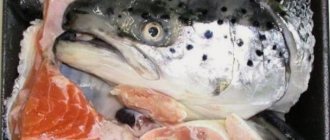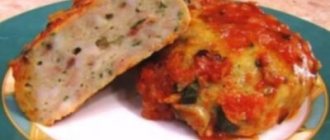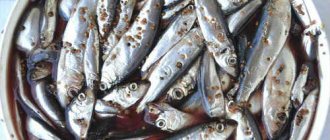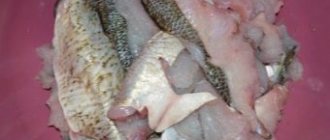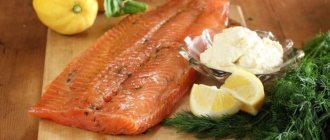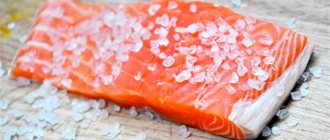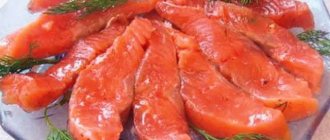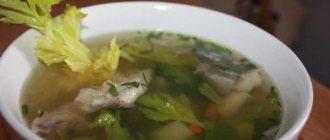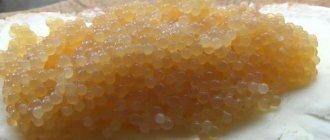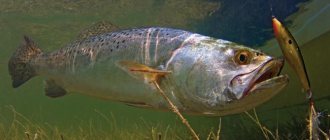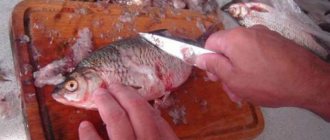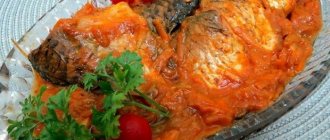Homemade canned fish
Working with an autoclave requires attention. To make canned food tasty, you need to follow certain rules.
- The autoclave operates at high temperatures and under significant pressure, so while cooking stew, you must not move it, drop it, remove the lid, or even just touch it. First, it must complete cooking, then the gas is turned off, and after the tank has completely cooled down, you can open it.
- Large fish, as a rule, have large bones removed, while small fish, such as sprat, are cooked in an autoclave whole and even with the head.
- The dish in the seaming container is laid out so that there is about 2 cm left to the neck, otherwise the lid will be torn off.
Important!
If canned fish in an autoclave is made in oil and fried beforehand, it is not recommended to use breading!
- Water is poured into the machine so that the lids of the jars are covered by 1-2 cm.
- Before putting the autoclave on fire, you need to check the tightness, whether the lid is closed, and whether everything is done correctly.
- Canned fish in an autoclave is made at a temperature of 100-120 degrees. During cooking, it must be constantly checked, otherwise the final result may be disappointing.
Classic recipe for canned bream
Composition (per 1 l):
- bream – 1 kg;
- carrots – 0.2 kg;
- onions – 0.2 kg;
- lemon juice – 10 ml;
- refined vegetable oil – 90 ml;
- salt – 20 g;
- bay leaf – 2 pcs.;
- black peppercorns – 4 pcs.;
- coriander seeds – 10 pcs.;
- mustard seeds – 20 pcs.
Cooking method:
- Clean and gut the bream well, wash and dry. Remove heads and tails, cut off fins. Fillet the bream. Cut it into pieces about 2 cm thick.
- Scrub the carrots, wash and dry with a napkin. Cut it into strips or chop it on a grater designed for making Korean salads.
- Peel the onion and cut into thin half rings.
- Wash half-liter jars and scald them with boiling water. Let them dry. Pour a teaspoon of oil into the bottom of each jar, add spices, which should first be washed and dried.
- Place several pieces of bream in each jar, filling them about a third, sprinkle with about 2-3 g of salt. Place half of the prepared vegetables into jars. Place half of the remaining fish on them. Season with salt and cover with remaining vegetables. Place the last pieces of fish on top and salt them. As a result, the jars will be almost completely filled, but about 1-1.5 cm will remain free on top.
- Pour a teaspoon of lemon juice into each jar and add 2 tablespoons of oil.
- Cover the jars with lids and sterilize in a water bath or in the oven. To sterilize a snack in a saucepan, place a towel in it, place the jars, pour water into the saucepan (level with the contents of the jars), put it on low heat and keep it on it for 3-4 hours after the water boils in the saucepan, adding warm water if necessary. Half-liter jars require 3 hours, liter jars 4 hours. To sterilize jars in the oven, place them on a wire rack in the center of the oven, with a container of water placed underneath them. Turn on the oven at 100-120 degrees and keep the jars in it for 5-6 hours. The fastest way to sterilize is in a slow cooker. To do this, place jars in the multicooker bowl, pour in water (to the level of the fish in the jars), then turn on the stewing program for 2 hours. Periodically check the water level and add hot water if necessary.
- After sterilization is complete, carefully remove the jars from the pan, multicooker or oven and roll them up.
- Turn the jars over, wrap them up, and leave them for 2 days. While cooling in a steam bath, canned food undergoes additional sterilization, which increases their resistance to unfavorable storage conditions.
Recipe for canned food in oil at home
Also check out these articles
- The best varieties of yellow peppers
- The best varieties of pears for the Moscow region
- Late Moscow cabbage variety
- Dracaena - types, reproduction and care
Recipe for canned food in oil at home
Fish in oil is the easiest way to make canned fish in an autoclave. You can use any fish for this dish at home. Small ones like sprat are also suitable, but it’s best to take crucian carp, rudd, catfish, silver carp or something similar.
Ingredients:
- Fish – 5 kg;
- Onion – 500 g;
- Carrots – 500 g;
- Vegetable oil – 150 g;
- Salt – 55 g;
- Black peppercorns;
- Laurel – 10 leaves.
Important!
Only rolled up jars can be placed in the autoclave for further preparation!
Preparation:
- The fish is first cleaned, the head is cut off, and the giblets are removed. If the fish is large, it needs to be cut into manageable pieces (to fit in a jar) and salted for 2-3 hours.
- Peel carrots and onions. The carrots are cut into rings or grated, and the onion is chopped into half rings.
- The jars for twisting are washed together with the lids. Peppers, vegetables and fish are placed in layers at the bottom. You also need to put 1 bay leaf in each half-liter jar. Oil is poured on top of the preservation and sealed.
- That's it, the jars are ready, they are placed in an autoclave and cooked at a temperature of 110 degrees for 1-1.5 hours. When cooked for a long time, the fish becomes soft and small bones become less noticeable.
After cooking, when the autoclave has cooled, these homemade canned fish are taken out, dried and hidden in the pantry.
How to cook sprat in tomato sauce in an autoclave
Many people’s favorite canned sprat in tomato sauce can be prepared independently using an autoclave. To do this, it is not at all necessary to clean the fish, especially if it is small. This is exactly how canned fish is prepared in an autoclave on an industrial scale - the sprat is taken straight from the head. In addition to fish, you will also need tomato sauce. To prepare it, you need to add tomato sauce (400 ml) to the onions and carrots fried in a frying pan. You will also need black peppercorns (3 pcs.), bay leaves (2 pcs.), 2 cloves of garlic and sugar (1 teaspoon). You can buy the sauce at the store or make it yourself from tomato paste, water and spices.
When the filling is ready, add salted sprat (500 g), mix everything well and compact it into jars. Canned food is prepared for 1.5 hours at a temperature of 110 degrees and a pressure inside the autoclave of 4 atmospheres.
A simple recipe for canned fish in an autoclave
A simple recipe for canned fish in an autoclave
Fish in its own juice is a very tasty and healthy dish. Catfish, silver carp or similar large fish are best suited for this recipe. You can also combine two or more types, for example, fatty varieties of fish with dietary ones.
Ingredients:
- Fish – 3 kg;
- Onion – 1 pc.;
- Black pepper – 9 peas;
- Vegetable oil – 3 tbsp. l;
- Laurel – 3 leaves.
Preparation:
- The fish is cleaned, gutted, and the head is removed.
- Clean fish is cut into medium pieces (to fit in a jar).
- The onion is peeled and cut into rings.
- Spices, onions, and then pieces of fish are placed in washed jars. They are placed tightly so that there is very little free space in the jar. But there must be 2 cm of free space left to the edge of the jar!
- Oil is poured on top of the fish (no more than a tablespoon per half-liter jar) and then the containers are rolled up.
- The rolled containers are installed in the apparatus. Preservation is done for 35-40 minutes at 110-115 degrees. When the autoclave is turned off, you need to wait for it to cool down, remove the jars and store them.
This canned fish does not take long to cook in an autoclave. If the fish is large, you should remove the bones in advance, because they may not have time to cook and will later end up in canned food.
Important!
If you put a little sugar in the can, the fish will not lose its shape and will not fall apart.
Canned herring with vegetables in a slow cooker
Composition (for 2.5 l):
- herring – 2 kg;
- carrots – 0.3 kg;
- onions – 0.6 kg;
- refined vegetable oil – 150 ml;
- water – 0.75 l;
- salt – 40 g;
- tea – 2 bags;
- laurel leaves – 4-6 pcs.;
- vinegar essence (70 percent) – 20 ml.
Cooking method:
- After defrosting, clean and gut the herring, cut into pieces of 2.5-3 cm.
- Scrub the carrots, wash and dry with a napkin. Grind it using a Korean salad grater or a regular one with large holes.
- Peel the onion and cut into thin half rings.
- Boil water, pour boiling water over a tea bag, brew for 10-15 minutes. Take out the bags and squeeze them out.
- Pour oil into the multicooker bowl. Place the fish in one layer, salt it, add a couple of laurel leaves. Place some vegetables on top and lightly salt them too. Continue layering the fish and vegetables into the bowl, remembering to add salt and spices. The last layer should be vegetables.
- Pour tea into the multicooker bowl.
- Run the device for 3 hours in extinguishing mode.
- After completing the main program, add vinegar essence and carefully mix the fish with vegetables. Simmer the food for half an hour in the heating mode.
- Wash and sterilize the jars. Boil the lids that go with them.
- Place the stewed fish among the jars. Roll them up and leave them to cool in a steam bath.
The preparations made according to this recipe should be stored in the cold: in the refrigerator or in the cellar, if the temperature in it does not rise above 12 degrees.
How to make gobies in tomatoes
We recommend reading our other articles
- Breed of geese Legart
- The best productive tomato varieties with descriptions and photos
- Feather removal machine
- The best early varieties of cherries with descriptions and photos
How to make gobies in tomatoes
Homemade canned fish is a dish for all times, for example, gobies in tomato cooked in an autoclave are very popular. In terms of price, this dish is inexpensive, but at the same time it can be consumed separately or added to other dishes.
Ingredients:
- Steers – 5 kg;
- Onion – 500 g;
- Tomato paste – 150 g;
- Sugar – 150 g;
- Vinegar – 2 spoons;
- Water – 1.7 l.
Preparation:
- The bulls wash themselves. The giblets, head, and outer husk must be removed.
- The prepared bulls are placed in a large bowl, salted and left for 2 hours.
- Now you need to fry the fish in flour until cooked.
- Chopped onions are fried in another frying pan. When it becomes transparent, add tomato paste and sugar.
- The finished frying is transferred to a pan of boiling water, and vinegar is immediately added. The resulting mass needs to be mixed thoroughly, and as soon as it boils, turn it off and remove from the heat.
- It is not necessary to sterilize the jars in advance, but it is important to wash them thoroughly, as well as the lids. A little tomato dressing (about 2-4 spoons) is poured into the bottom of the jars, then the bulls are placed. When the fish is laid out, the remaining dressing is distributed. It is important to leave 2 cm free in each jar up to the neck.
- The prepared containers are rolled up and placed in an autoclave. The device is placed on the fire and first heated over medium heat so that the temperature on the thermometer reaches 110 degrees. After this, the fire is reduced and maintained at this level for 1 hour.
After the canned fish has been cooked in the autoclave for an hour, turn off the stove, wait until the autoclave has cooled down, and then take out the canned fish.
Canned herring with vegetables
You can cook herring with vegetables, you get a complete dish - fish with a vegetable side dish.
- herring – 1.5 kg;
- tomatoes – 1.5 kg;
- carrots – 0.5 kg;
- onion – 0.5 kg;
- refined vegetable oil – 120 ml;
- table vinegar (9%) – 50 ml;
- sugar – 60 g;
- salt and pepper to taste.
Cut the skin of the tomatoes and scald with boiling water. Then transfer to cold water and remove the skin. Peel the carrots and onions. Grate the carrots and chop the onion into small cubes. Peel the herring and cut into pieces.
Recipe for canned fish in broth
Recipe for canned fish in broth
At home, a wide variety of fish dishes are prepared in an autoclave. This recipe uses a strong broth to pour over the fish. After such canned food sits in the jar for some time, the liquid thickens a little like jellied meat.
Ingredients:
- Silver carp – 3 kg;
- Dill, parsley and celery - 1 medium bunch;
- Tomato paste – 50 g;
- Salt - to taste;
- Black pepper - to taste;
- Laurel - 1 leaf in each jar;
- Water.
Important!
If the temperature in the autoclave is not maintained, the fish will end up either raw or overcooked.
Preparation:
- The fish is cleaned and gutted. A strong broth is brewed from the head, fins, and tail. Herbs, tomato paste, and spices are added to it.
- The fish is cut into medium pieces and fried in breading.
- The washed jars are filled with 2-3 cm of freshly prepared broth. Then they put fish in them. All that remains is to put the laurel and add the broth so that there is still 2 cm left to the edge of the jar.
- This dish is prepared for half an hour in an autoclave at 110 degrees.
Classic recipe in the oven
Canned herring, prepared at home with a basic set of ingredients, can be consumed as an independent dish, and can also be used to prepare salads and soups.
What ingredients will you need?
For canning herring we use:
- high-quality vegetable oil (preferably from sunflower seeds), odorless – 180-250 ml;
- defrosted herring (choose medium-sized fish) – 2 pcs.;
- black pepper (choose in the form of peas) – 8 peas;
- salt (select for canning) – 20 g;
- spices (you can use dry clove buds, mustard seeds or dry dill seeds) – 7-10 g.
The type of spices can be chosen according to taste preferences.
Step-by-step cooking process
The stages of canning herring are as follows:
- First you need to wash the herring carcasses.
- Next, the fish must be cleaned of scales. It is recommended to carry out manipulations with a specialized knife so that the scales do not scatter too much around the room.
- Cut off the head of the cleaned carcass along with the gills, tail and fins.
- Carefully open the belly of the herring and remove all the insides. When removing giblets, it is important not to damage the integrity of the gallbladder, otherwise it will be impossible to wash out the bitterness from the carcass.
- Then you need to remove large bones from the fillet. The spine and small bones can be left. They soften during cooking.
- After completing the procedures, it is recommended to rinse the fish thoroughly and remove excess liquid with a paper towel (a cloth towel is not recommended, since it is then difficult to wash it off from the fishy smell).
- Cut each fish carcass into pieces approximately 2.5-3 cm wide.
- Next, it is advised to sterilize the container. For a given amount of ingredients, it is enough to use 2 jars with a capacity of 0.5 liters. You can sterilize using the following methods:
- Place the jars upside down on the oven rack. After this, the oven must be turned on at 130 degrees. Keep the container in the oven for at least 20 minutes. The door of the oven compartment must not be opened during sterilization. Also, you can’t put jars in an already preheated oven, as they will immediately crack due to the temperature difference;
- pour distilled water into the multicooker (approximately 0.7-1 l). Place jar lids in water. Then you need to put a grate in the device for steaming dishes. Place the jars on the wire rack. Turn on the device in steaming mode. The recommended holding time for cans is at least 10 minutes;
- put the jars in the microwave. Set the device to maximum power. Turn on the microwave for approximately 40-50 seconds. To sterilize the lids, they must be placed in a deep plate with water. Set the processing time to 5 minutes;
- Pour water (about 1 liter) into a wide saucepan. Place the lids in the water and place the jars upside down. Place the pan on a medium heat burner. Keep the pan on the fire for at least 10 minutes (time must be counted from the moment the water boils).
- Wait for the jars to cool slightly.
- While the jars are cooling, it is advisable to mix the salt with the selected spices and peppercorns.
- Next, you need to put a layer of fish on the bottom of the jar and sprinkle it with a mixture of point 10. Then again a layer of fish and spices. Repeat manipulations until all ingredients are used. In this case, the last layer needs to be fish.
- After this, vegetable oil should be poured into the jars. It should completely cover the contents.
- Cover the jars with lids (no need to tighten them) and place them in a cold oven.
- Set the oven temperature to 180 degrees and wait until bubbles appear in the oil.
- Then the oven temperature should be reduced to 100 degrees. You need to simmer the preserved food at this temperature for about 5 hours. In this case, you need to check that there are always bubbles in the oil. If the bubbles disappear (this means that the required temperature for preserving fish is not maintained), then you need to increase the temperature in the oven by 3-5 degrees.
- When simmering canned food, it is not recommended to open the oven door.
- After 5 hours, the cans of canned food should be removed from the oven, immediately rolled up and turned upside down. Cover the workpiece with a blanket.
After 24 hours (when the canned food has cooled), the fish can be served or stored in a cool place.
If you want canned herring to have a smoked taste, then you need to put 2-3 prunes in the jar when canning. You can also prepare the preparation by including in the set of products natural tomato paste in the amount of 100 ml and 5 ml of vinegar essence (70%).
Canned fish in an autoclave with beans
Canned fish in an autoclave with beans
Canned fish with beans is an independent dish that is perfect for lunch and dinner.
Ingredients:
- Pike or gobies – 2 kg;
- Dry beans – 1 tbsp.;
- Onion – 2 pcs.;
- Tomato paste – 100 g;
- Vegetable oil – ½ tbsp.;
- Salt – 45 g.
Preparation:
- The night before cooking the canned food, pour cold water over the beans. In the morning, the beans are washed.
- The pike is gutted, the head, fins, and tail must be removed. The fillet is cut into medium pieces (preferably there are no bones in the meat), and then salted.
- The onion is peeled and cut into cubes, then it needs to be fried in a frying pan. When it becomes transparent, add the tomato and fry the mixture for another 3 minutes. That's it, the tomato dressing is ready.
- The jars are washed in advance. Add a little tomato dressing to the bottom. Then you need to lay the fish and beans in layers. When the jar is full, add tomato dressing, leaving an empty space of up to 2 cm from the edge of the neck.
- Homemade canned fish is rolled up and cooked in an autoclave for 1 hour at a temperature of 110 degrees.
Canned fish in an autoclave turns out no worse than those sold in the store. The fish retains its juice, taste, and remains very healthy and nutritious. These dishes are simple to prepare. The main thing is to find a suitable recipe that the family will like and follow the cooking rules.
How to prepare canned fish from pike in oil without pumping up the pressure?
Pike is a finicky fish, as it often turns out dry when cooked. But canned food with the addition of oil turns out simply excellent. The fish becomes tender, soft and juicy, much tastier than industrially canned food.
Required products (per 700 g jar):
- 300-400 g pike;
- 1.5 tsp. salt;
- 3-4 buds of cloves;
- 6-8 peas of hot pepper;
- 2 bay leaves;
- 2 tbsp. vegetable oil.
How to cook:
1. Place half the spices and a teaspoon of salt at the bottom of the jars.
2. Next, fill the jar with the 1st layer of fish and add the remaining salt.
3. Compact the second layer of fish pieces, leaving a space of 1-2 cm. Top with the remaining spices and vegetable oil.
4. Cover the jars with lids, but do not roll them up. Place everything in the autoclave.
5. Pour water so that it covers the jars by a third. Close the pressure canner, light the stove and cook for 35 minutes.
6. Afterwards, reduce the gas slightly so that the pressure is established at 1.5 atmospheres and wait another 1.5 hours.
Cool the autoclave, remove the jars and immediately roll up their lids (while they are hot). Cover with a warm blanket and leave to cool.
And if you have pike left, fry it in a frying pan in sour cream or mayonnaise. The meat will become much juicier this way. For detailed recipes, see another article.
